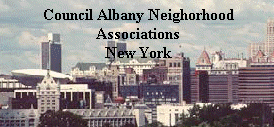The Harriman State Office Campus represents a style of
large-scale development prevalent between the 1950s and 1970s.
The World Trade Center, the Empire State Plaza and the University at
Albany campus are other examples of this phenomenon of anti-urban urban
renewal. They are set apart, worlds onto themselves.
Some people call the Harriman campus "the gulag'' because of its
isolation. It's uninviting from the outside and lacks a clear entrance.
One enters only by navigating an unwelcoming wrap-around road system.
Hopefully, this type of development won't be seen again. Take the
blueprint emerging for the World Trade Center site as an example of
current thinking. It calls for reconnecting streets disrupted when the
complex was built, adding significant retail and residential space, and
enhancing transit services.
Yet look at the cover of the recently released report,
"Redevelopment Strategy for the Harriman State Office Campus,'' and
you'll see the same old suburban, car-oriented campus design advanced by
Gov. George Pataki as a "high-tech center for the 21st century.''
Creating a Harriman Research and Technology Campus as a "place
where university researchers and technology entrepreneurs can innovate
side-by-side'' couldn't be better for Albany and its metro area. But
indications that the existing auto-centric pattern will remain are
dreadful on all accounts. One hopes the state will do some more planning
on the road to delivering a good concept.
In a Legislative Gazette article on the campus proposal, Ray Bromley,
a professor in UAlbany's Department of Geography and Planning, is
reported as noting that the suburban environment would not appeal to
those in the information technology fields.
So one can only wonder why such a visionary concept has come
packaged, at least initially, so mundanely.
Why didn't the "environmental'' governor present a campus
meeting the highest standards for being green, with state-of-the-art
sustainable buildings, waste prevention and recycling, storm-water
pollution prevention and energy conservation? Wouldn't that create the
right setting to foster cutting-edge research and development?
Why isn't the campus envisioned as the linchpin for a new generation
of non-auto dependent mobility, rather than a collection of parking
lots? Kristin Younger, a Capital District Transportation Authority
planner, says the existing campus is not easy to serve with mass
transit. The proposed campus doesn't correct that shortcoming.
Why doesn't the concept link the Harriman campus, UAlbany and its
nearby Center for Environmental Sciences and Technology Management with
surrounding streets?
Why is there only a qualified possibility of including residential
development when the campus is projected as attracting 8,000
private-sector workers?
UAlbany will be a big player in the high-tech campus. So far, the
university has left a lot to be desired in physically improving its
community, both uptown and downtown. The most recent example is the
Empire Commons dormitory development with its back to Fuller Road.
UAlbany President Karen Hitchcock talks about a desire "to
involve the entire community in the conversation.'' Saying it's
"time for a new vision,'' the governor must be thinking about
something more than the existing campus design.
Let's have that conversation on how a tech research-and-development
campus should be designed to make Albany and the region healthy, livable
and attractive.
Paul M. Bray is the founding president of the Albany Roundtable Civic
Lunch Forum.
